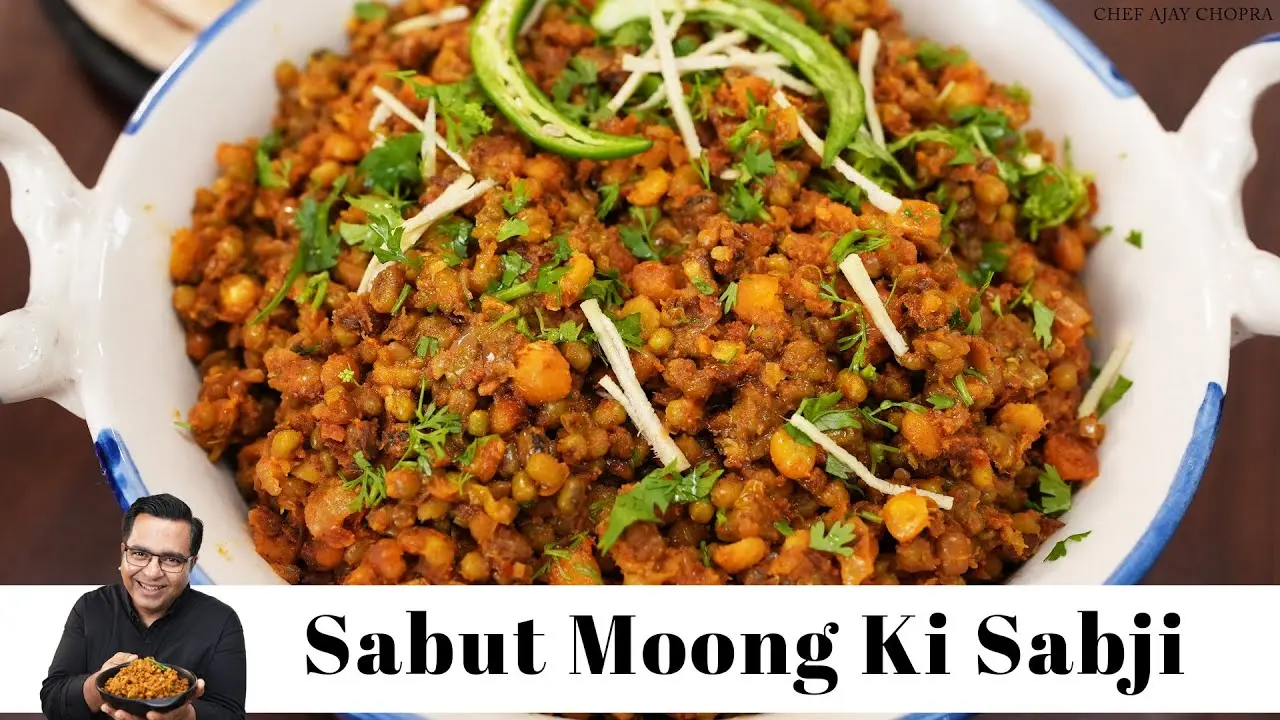
Sabut Moong Sabji Recipe | मूंग की सब्जी

40 Mins

5-6 People

05 Mins
Introduction
When I was younger, dal and sabzi were staples in our household, but this unique preparation of whole green gram (sabut moong) and split Bengal gram (chana dal) quickly became a family favorite. I first encountered this dish during a visit to a friend's house in Madhya Pradesh, and I was amazed by its simplicity and robust flavors. This sabzi, unlike the usual mashed dal, retains the texture of the lentils, making it a delightful change.
One of the fascinating aspects of this Sabut Moong Sabji is how it marries the rich culinary traditions of Maharashtra and Madhya Pradesh. It's a perfect dish for those days when you're out of vegetables but still want something nutritious and delicious. The key to its unique taste lies in the careful cooking of the dal so that it remains intact yet perfectly cooked.
Recipe of Sabut Moong Sabji | मूंग की सब्जी
Portion servings: 5-6 pax
Preparation time: 5 mins
Cooking time: 40 mins
Ingredients
- Whole green moong dal: 1 cup (soaked)
- Chana dal: ½ cup (soaked)
- Water: 3-4 cups
- Salt: 1 tsp
- Turmeric powder: ½ tsp
- Oil: 2 tbsp
- Jeera (cumin seeds): 1 tsp
- Cloves: 3-4 pcs
- Black peppercorns: 6-8 pcs
- Bay leaves: 2 pcs
- Garlic: 2 tbsp (chopped)
- Onion: 1 large (chopped)
- Salt: 1 tsp
- Turmeric powder: ½ tsp
- Kashmiri red chilli powder: 1 tsp
- Coriander powder: 2 tsp
- Jeera powder: 1 tsp
- Tomato: 2 medium-sized pcs (paste)
- Sabji masala: 1 tbsp
- Coriander leaves: 1 tbsp (chopped)
- Ginger juliennes: ½ tbsp
- Ghee: 1 tbsp
Instructions
Step 1: Boiling the Dal
-
In a pressure cooker, add the soaked green moong dal and chana dal.
-
Add salt, turmeric powder, and enough water to cover the dal.
-
Close the lid and cook until you hear 1 whistle.
-
Ensure the dal is not overcooked. Set aside after releasing the pressure.
Step 2: Tempering
-
Heat oil in a pan over medium heat.
-
Add cumin seeds, cloves, black peppercorns, and bay leaves.
-
Once they start to crackle, add finely chopped garlic.
-
Sauté until the garlic turns golden brown.
Step 3: Cooking the Onions and Spices
-
Add chopped onions and a pinch of salt.
-
Sauté until the onions turn golden.
-
Add turmeric powder, Kashmiri red chilli powder, coriander powder, and cumin powder.
-
Cook the spices well until the raw smell disappears.
Step 4: Adding Tomato Puree
-
Add the tomato puree to the pan.
-
Cook until the tomato mixture thickens and the oil starts to release from the sides.
-
Add sabji masala and cook for another 2-3 minutes.
Step 5: Combining Dal and Tempering
-
Add the strained dal to the pan with the tempering mixture.
-
Mix well and cook for 3-4 minutes with the lid covered.
Step 6: Finishing Touch to Sabji
-
Garnish with fresh coriander leaves and ginger juliennes.
-
Serve hot with rice or chapatis.
Enjoy your delicious and nutritious Sabut Moong Sabji!
About the Recipe
Sabut Moong Sabji is a delicious and nutritious dish that uses whole green gram and split Bengal gram as its primary ingredients. This recipe is distinct in its approach to keeping the lentils whole, providing a satisfying texture that pairs wonderfully with spices and aromatics. Unlike typical dals, this sabzi is prepared to be semi-dry, making it an excellent accompaniment to chapatis or rice.
The cooking process involves soaking the lentils, lightly boiling them with just salt and turmeric, and then giving them a flavorful tadka (tempering) with a mixture of spices and tomato puree. This method ensures that the lentils remain intact while absorbing the rich flavors of the spices. The addition of fresh coriander and a squeeze of lemon juice enhances the overall taste, making this sabzi a wholesome and enjoyable meal.
Cooking Tips
- Soaking the Lentils: Ensure you soak the moong and chana dal for at least two hours. This helps in reducing the cooking time and keeps the lentils from becoming mushy.
- Boiling the Lentils: Add only a pinch of turmeric and salt while boiling. Overcooking the lentils will make them too soft.
- Tempering: Use fresh spices for the tadka to enhance the aroma and flavor. Cook the onions and garlic until golden brown to add a deep, rich taste.
- Consistency: If you prefer a drier sabzi, make sure to strain the lentils well before adding them to the masala.
- Serving: Garnish with fresh coriander and ginger juliennes for a burst of freshness.
Pairing Guide
- Chapati or Paratha: Sabut Moong Sabji pairs wonderfully with chapatis or parathas. The semi-dry texture of the sabzi complements the soft, warm bread.
- Rice: Serve this sabzi with steamed basmati rice or jeera rice. The light and fluffy rice balance the robust flavors of the sabzi.
- Side Salad: A simple cucumber, tomato, and onion salad with a dash of lemon juice can add a refreshing crunch to your meal.
- Yogurt: A bowl of plain yogurt or raita on the side can enhance the meal, providing a cool contrast to the spices.
Frequently Asked Questions about Sabut Moong Sabji
-
What is Sabut Moong Sabji? Sabut Moong Sabji is a semi-dry dish made from whole green gram (moong) and split Bengal gram (chana dal), cooked with spices and served as a sabzi.
-
How do you keep the lentils from becoming mushy? Soaking the lentils before cooking and boiling them with just a pinch of turmeric and salt helps maintain their shape.
-
Can I use other lentils for this recipe? Yes, you can experiment with other whole lentils like masoor or urad dal, but the texture and flavor might vary.
-
Is this recipe suitable for vegans? Yes, this recipe is vegan as it uses plant-based ingredients and does not include any dairy or animal products.
-
How long can I store Sabut Moong Sabji? It can be stored in an airtight container in the refrigerator for up to 3 days. Reheat it thoroughly before serving.
-
Can I make this sabzi without onion and garlic? Yes, you can skip the onion and garlic if you prefer, but the flavor profile will change slightly.
-
What can I use instead of tomato puree? You can use finely chopped fresh tomatoes or canned tomatoes as an alternative to tomato puree.
-
Is it necessary to use a pressure cooker? While a pressure cooker speeds up the process, you can cook the lentils in a regular pot. It will take longer, so keep an eye on the cooking time.
-
What are the health benefits of Sabut Moong Sabji? This sabzi is high in protein and fiber, low in fat, and packed with vitamins and minerals, making it a healthy addition to your diet.
-
Can I freeze Sabut Moong Sabji? Freezing is not recommended as the texture of the lentils may change. It is best enjoyed fresh or within a few days of preparation.
